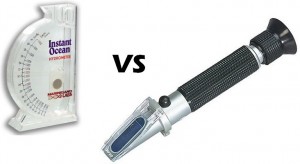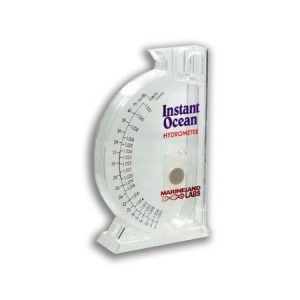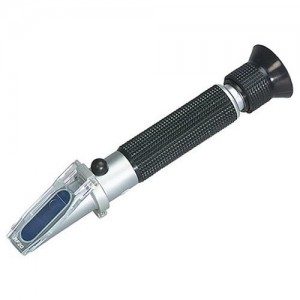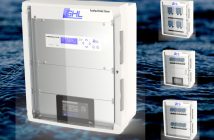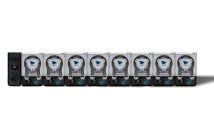There are two items typically used by the home aquarium keeper to measure salinity, the swing-arm hydrometer and the refractometer. Each one of them measures the salinity or specific gravity of the water sample, but each of them does it differently. These differences in measuring are what leads to one device being much better and consistent than the other.
The Hydrometer:
Twenty years ago, most saltwater aquarium keepers would have used a hydrometer to measure the salinity of their water. The device is very simple in both its design and use. The hobbyist dips the entire unit into their aquarium, filling it to the top with saltwater. The unit, now full, is then removed from the tank and set on a level surface. The swing-arm within the hydrometer will rise to indicate the specific gravity (also known as relative density) of the water sample. The more dense the water, the higher the arm will rise.
The swing-arm hydrometer is very cheap and easy to operate, but it’s not without its limitations. Bubbles can easily get stuck to the swinging arm of the device and cause an inaccurate reading. Additionally, the moving parts can degrade over time also leading to bad readings. The last major drawback to this type of salinity measuring device is the lack of temperature adjusting. As water warms or cools, it becomes less dense or more dense respectively. If the water is colder or warmer than what the scale of the device is calibrated to (usually 77 degrees Fahrenheit), then the hobbyist must do a little math to determine the right salinity. Regardless of these drawbacks, the swing-arm hydrometer is still widely used today. Most of the people that use them are beginner aquarists, but I’ve even seen major institutions using them, mostly for a quick check though.
The Refractometer:
Refractometers are another hand-held tool that aquarists use to measure salinity in their tanks. These devices measure the refractive index of the water being tested and display the results on a scale similar to that on a swing-arm hydrometer. The difference with this device, when compared to the hydrometer, is that it doesn’t directly measure the density of the liquid, but measures how light is bent through the liquid. The density of the liquid will cause variations of the light refraction in the liquid, with more dense light causing a smaller amount of refraction.
The major benefit of the refractometer over the hydrometer is accuracy. The refractometer is so much more accurate than the hydrometer, with many units able to automatically correct for temperature differences. For these reasons, the refractometer has replaced the hydrometer as the preferred salinity measuring equipment. Despite it’s superior build quality and performance, there is a few minor drawbacks. For one, the refractometer has to be calibrated regularly. It’s easy to do, but often overlooked and can be viewed as another hassle. To calibrate, just add distilled water to the glass lens on the front of the device and zero out the reading. Zeroing the reading is done by adjusting the calibration screw, typically located on the top of the refractometer. Another potential drawback is the refractometer requires some form of light to get a good reading. The light is critical to measuring salinity, but not a lot of light is required. Some refractometers now come with built-in lights so you no longer have to turn on the room’s light or stand close to your tank for illumination. The last drawback is cost. The swing-arm hydrometer costs under $10 in many cases, but a good refractometer is pushing $50. A minor expense for a good piece of equipment, but for some it is a big deal.
Image Courtesy of Marine Depot
Overall, the refractometer is head-and-shoulders above the hydrometer. The price might be higher, but the performance certainly warrants the price difference. If you have a swing-arm hydrometer, do yourself a favor and purchase a good quality refractometer. Your tank’s salinity will be more consistent with one.


